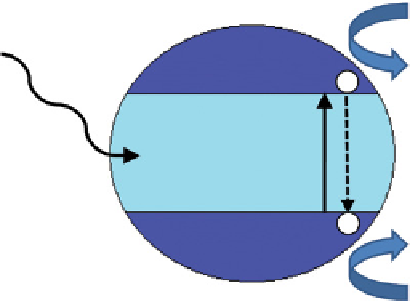Environmental Engineering Reference
In-Depth Information
The main focus of current work on methods for increasing photocatalytic activity is on the modification of the surface
chemistry and controlled growth of TiO
2
nanocrystals. There has been much recent progress on the synthesis of nanocrystals
with a higher proportion of reactive facets, and theoretical modeling has assisted by providing an understanding of the influence
of surface energy effects in determining morphology as the crystal size is reduced [11]. Attempts have also been made to
increase the reaction rate by surface loading with noble metal clusters [12, 13], to enhance photocatalytic activity by doping
with metals to inhibit electron-hole recombination by charge trappping [14, 15], and to achieve visible light photocatalysis by
doping with various metals and nonmetals [16, 17].
There are many existing and potential applications of photocatalysis in drinking water purification and wastewater treatment,
and it is often claimed that the advantage of photocatalytic treatment with respect to chlorination is that it is able to degrade
organic pollutants without the production of toxic by-products. However, this is not entirely accurate as problems may still be
experienced due to the formation of long-lived toxic intermediates by complex photodegradation processes [18, 19]. It is there-
fore essential to develop a more comprehensive knowledge of the reaction pathways in order to ensure the complete elimination
of any toxic compounds produced.
10.2
Photocatalytic reactioN
The basic mechanism of photocatalysis is illustrated schematically in figure 10.1. Incident photons with energies greater than
that of the semiconductor band gap create electron-hole pairs (e
-
, h
+
) by excitation of electrons from the valence band to the
conduction band. These electron-hole pairs take part in redox reactions with acceptor and donor species on the surface of the
photocatalyst [20, 21]. Reactions between valence band holes and adsorbed water molecules or surface hydroxide ions lead to
the formation of hydroxyl radicals according to the equations:
+
•
+
(10.1)
hHOHOH
+ →+
2
hOH O
+
+ →
-
•
(10.2)
Dissolved oxygen molecules trap conduction band electrons to form superoxide ions that can react with hydrogen ions to
form hydroperoxyl radicals:
-
+
•
−
+
•
2
(10.3)
eOHOH O
++→+→
2
2
Hydrogen peroxide may be formed by reaction of hydroperoxyl radicals with hydrogen ions and may act as an oxidant or
dissociate into hydroxide ions and hydroxyl radicals:
eHOH HO OH
-
+
•
+ →→+
+
-
HO
•
(10.4)
2
2
2
Ox
hν
Reduction
Conduction band
Ox
-
-
+
Red
+
Valence band
Oxidation
Red
figure 10.1
Processes involved in the photocatalytic reaction. Reproduced with permission from Ref. [83]. © 2011, Nano Science and
Technology Institute.

